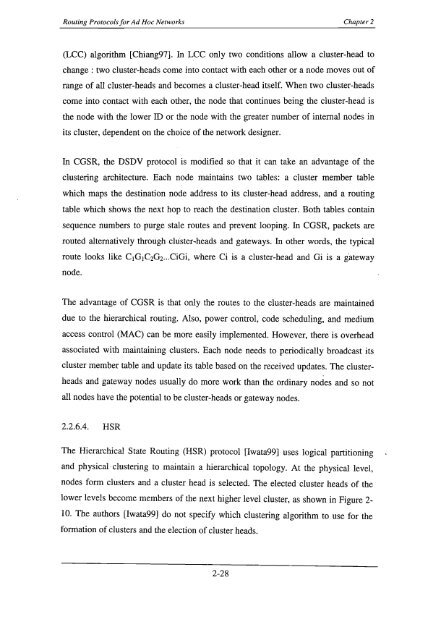Gugrajah_Yuvaan_ Ramesh_2003.pdf
Gugrajah_Yuvaan_ Ramesh_2003.pdf
Gugrajah_Yuvaan_ Ramesh_2003.pdf
Create successful ePaper yourself
Turn your PDF publications into a flip-book with our unique Google optimized e-Paper software.
Routing Protocols for Ad Hoc Networks Chapter 2<br />
(LCC) algorithm [Chiang97]. In LCC only two conditions allow a cluster-head to<br />
change: two cluster-heads come into contact with each other or a node moves out of<br />
range of all cluster-heads and becomes a cluster-head itself. When two cluster-heads<br />
come into contact with each other, the node that continues being the cluster-head is<br />
the node with the lower ID or the node with the greater number of internal nodes in<br />
its cluster, dependent on the choice of the network designer.<br />
In CGSR, the DSDV protocol is modified so that it can take an advantage of the<br />
clustering architecture. Each node maintains two tables: a cluster member table<br />
which maps the destination node address to its cluster-head address, and a routing<br />
table which shows the next hop to reach the destination cluster. Both tables contain<br />
sequence numbers to purge stale routes and prevent looping. In CGSR, packets are<br />
routed alternatively through chister-heads and gateways. In other words, the typical<br />
route looks like C1G1C2G2••.CiGi, where Ci is a cluster-head and Gi is a gateway<br />
node.<br />
The advantage of CGSR is that only the routes to the cluster-heads are maintained<br />
due to the hierarchical routing. Also, power control, code scheduling, and medium<br />
access control (MAC) can be more easily implemented. However, there is overhead<br />
associated with maintaining clusters. Each node needs to periodically broadcast its<br />
cluster member table and update its table based on the received updates. The cluster<br />
heads and gateway nodes usually do more work than the ordinary nodes and so not<br />
all nodes have the potential to be cluster-heads or gateway nodes.<br />
2.2.6.4. HSR<br />
The Hierarchical State Routing (HSR) protocol [Iwata99] uses logical partitioning<br />
and physical- clustering to maintain a hierarchical topology. At the physical level,<br />
nodes form clusters and a cluster head is selected. The elected cluster heads of the<br />
lower levels become members of the next higher level cluster, as shown in Figure 2<br />
10. The authors [Iwata99] do not specify which clustering algorithm to use for the<br />
formation of clusters and the election of cluster heads.<br />
2-28
















